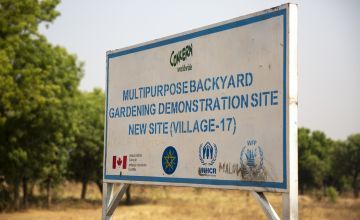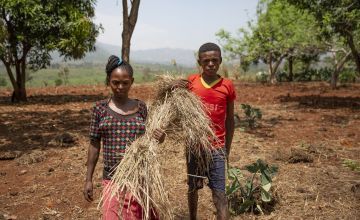
Read our 2024 annual report

Knowledge Hub
Over the last six years, Ethiopia has faced back-to-back droughts — the worst the country has experienced in over 50 years. In 2016, 10.2 million people were reported to be in urgent need of food assistance. That year, Concern CEO Dominic MacSorley warned:

“We need to act now. If we wait to see the images that haunted us thirty years ago before we intervene, we will have failed the people of Ethiopia. This is a country which has worked hard to develop its economy and strengthen how it copes with chronic climate challenges. The government is leading and driving this response — but the scale of this crisis is beyond the abilities of any one nation.”
Six years later, climate change in Ethiopia continues to pose a threat, with the latest Integrated Food Security Phase Classification (IPC) analyses suggesting 12.9 million Ethiopians are now in urgent need of food assistance. Here’s what happened in 2021, and what we may see in 2022.

Ethiopia is one of the most vulnerable countries to climate change
This is not only because the country is prone to droughts and floods, but also because the majority of Ethiopians (80-85%) depend on agriculture and pastoralism for their livelihoods. With each successive drought and flood, the impact gets even greater — especially on poverty, hunger, and livelihoods — as those furthest behind face even greater barriers and struggle to catch up. The 2011 Horn of Africa drought left 4.5 million Ethiopians in need of food assistance.
Drought is especially dangerous here as Ethiopia is also prone to the effects of El Niño and La Niña: When the country experienced two consecutive failed rainy seasons in 2015 (resulting in the lowest recorded rainfalls in 55 years for some parts of the country), this weather emergency was exacerbated by the El Niño phenomenon — a warming of the central to eastern tropical Pacific that occurs every two to seven years. The United Nations Office for the Coordination of Humanitarian Affairs labeled the 2015-16 El Niño one of the 3 strongest episodes on record, with lasting impact on 60 million people around the world. 9.7 million of those people were Ethiopian.
The climate crisis has exacerbated extreme weather events in Ethiopia
The El Niño phenomenon is a warming of the central to eastern tropical Pacific that occurs every two to seven years. During an El Niño event, sea surface temperatures across the Pacific can increase by 1–3°F for anything between a few months and two years.
The last big El Niño happened in 1998, and due to climate change and the general trend towards a warmer global ocean, experts are unsure exactly how this one will play out. What can be observed from current trends however, is that the impact around the world is becoming more extreme. While it’s causing drought in Ethiopia, it’s also causing heavy rainfall and flooding in Somalia, Malawi, and Mozambique.

What was the state of climate change in Ethiopia in 2021?
In 2021, Ethiopia’s Somali region continued to be the epicentre of a three-season drought that has struck the eastern Horn of Africa; the region also faced flash floods this year, which were equally devastating. Neighboring countries Kenya and Somalia have already declared drought emergencies, and a joint report published at the end of last year by EU Civil Protection and Humanitarian Aid (ECHO), the Food and Agriculture Organisation (FAO), and the Famine Early Warning Systems Network (FEWS) indicates that crops and water levels will continue to decay “rapidly” over the next few months as part of an “exceptional drought” characterised by lowest on-record rainfalls in many areas, hotter-than-normal land surfaces, and reduced harvests.
The net effects of these climate crises become all too human, leaving the country in its greatest hunger crisis in 20 years as millions go without food and clean water. Currently, 5.9 million Ethiopians face acute food needs, and 3.9 million Ethiopian women and children are nutritionally vulnerable. As of July, 2021, nearly half a million Ethiopians were displaced due to drought and seasonal flooding. The numbers are stark and the scale of the crisis is difficult to comprehend as the situation overall becomes more precarious with complementary crises like the recent locust invasion and COVID-19.
What’s predicted for Ethiopia in 2022?
The same ECHO, FAO, and FEWS report for 2021 outlines some troubling predictions for next year, especially as La Niña is expected to continue through August, 2022. La Niña is the opposite of El Niño: an intensification of normal weather patterns. This causes ocean surface temperatures to cool down as winds strengthen and blow warm water towards the west.
ECHO, FAO, and FEWS link this to a 90% chance of La Niña-like climate between March and May of 2022. While La Niña is linked to increased rainfalls (and, it should be said, is not an effect of global warming), climate change has decreased the reliability of these rains in recent years. “Even if [March, April, and May] rains are normal, the region will experience lingering long-term rainfall deficits,” the report predicts. That’s still the best-case scenario, as a poor rainy season would result in an “unprecedented (since 1981) sequence of four below-normal rainfall seasons, which could further exacerbate the current humanitarian challenges.”
In southern and eastern Ethiopia, where food security levels decreased over 2021, more crisis-level and pre-famine–level conditions could continue to prevail, and even worsen.

What can be done to address the climate crisis in Ethiopia?
At this point, the effects of climate change in countries like Ethiopia are here to stay. The best we can do is offset the risks they pose, especially to the most vulnerable people, through proactive health and nutrition interventions, improving livelihoods and agricultural techniques, and providing cash assistance to those whose incomes are impacted by ongoing droughts.
Early warning systems and rapid responses are some of the best tools we have in the face of a famine. In fact, this combination helped Somalia to avert a drought-induced famine in 2017. Concern’s Early Warning, Early Action (EWEA) system is a “no regrets” strategy: Instead of responding to an emergency based on certainty, we began responding (proportionately) to the probability of a disaster. In some cases, this means that we responded early to the signs of a crisis that didn’t come to pass. But, in the long term, EWEA still saves money: An ounce of prevention is worth a pound of cure.

Concern in Ethiopia: An integrated approach to offsetting the hazards of climate change
In 2020, Concern’s emergency nutrition response programmes reached over 253,000 of the most vulnerable Ethiopians. This included treating over 75,000 cases of moderate or acute malnutrition in children, and pregnant and lactating women at 230 nutrition sites, and reaching almost 154,000 people with information and education about how to ensure good nutrition and health for babies and young children.
Additionally, our recent LEAF Project in Ethiopia's Wolayita Zone addressed how to treat current cases of acute malnutrition while preventing future cases through sustainable livelihoods. Implemented alongside our Resilience, Graduation with Evidence (REGRADE) programme, this combined effort built jobs and food security by improving harvest quality and yields. At the same time, we improved the resilience against risks of climate change and worked with over 1,700 families in the area to further their economic stability by diversifying their income, assets, and skills, while ensuring that they also had access to financial services, capital, and assets. One special focus was working with female-headed households in Wolayita, who are often left further behind in terms of confidence, assets, and access. By the end of the project, we reached 10,260 people directly with LEAF, including 624 families that were female-led.
Find out more about what we do
Other ways to help
Corporate support
Is your company interested in working together for a common cause?
Fundraise for Concern
From mountain trekking to marathon running, cake sales to table quizzes, there are lots of ways you can support our work.
Buy a gift
With an extensive range of alternative gifts, we have something to suit everybody.
Leave a gift in your will
Leave the world a better place with a life-changing legacy.
Volunteer with Concern
The lots of ways to get involved with our work as a volunteer
School fundraising
Without the generous support from schools, we wouldn't be able to do the work that we do.

